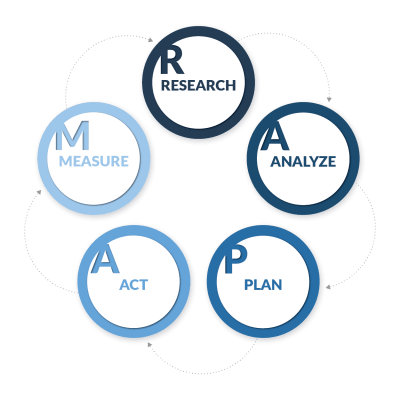Maximizing Success from your Initiatives
Overview
Our Mission at PracticalCSM.com is to provide customer success managers and indeed all professionals that have a customer facing role, with best practice tools and techniques that they can learn and apply to their real world situations to gain speedy and measurable benefits.
This short article is about my RAPAM Model, and how you can apply it to complex initiatives to help maximize their success, both in terms of reducing the time it takes for your initiative to start delivering value, and in terms of increasing the overall quality and quantity of value that your initiative ultimately produces.
When to Apply the RAPAM Model
There are many tasks that we accomplish in our work and home lives that are quick and simple to complete, but at least occasionally for everyone and regularly for many of us, we are also called upon to undertake more complex and/or long term assignments that require a substantial amount of effort before they can be satisfactorily completed.
If the initiative is a relatively simple one – perhaps involving only yourself and maybe one or two other people, and perhaps with only a handful of tasks to complete – then it may be best just simply to get on with it. However if the initiative is more complex, involving multiple people or even multiple groups of people and multiple tasks that need to be completed over a longer timeline, then it probably pays to follow a more clearly defined process in order to maximize your productivity and efficiency and to both decrease the time taken to start getting results and increase the overall level of value returned.
When you come across such an initiative (be it one of your own, or perhaps one you are helping a friend, colleague, family member or a customer with), you might want to consider using my own model for managing such initiatives, which is called RAPAM.

RAPAM stands for Research, Analyze, Plan, Act, and Measure. By following this sequence of activities, you are more likely to gain a better quality result from your efforts and to accomplish your objectives more speedily and efficiently than would otherwise be the case. RAPAM works for a customer success manager’s own initiatives such as an onboarding or adoption project, and works equally for helping with a CSM’s customer’s initiative such as the strategy that the customer has purchased the CSM’s company’s solutions to support. In fact it also works for any professional in any role who encounters complex initiatives that need to be accomplished, and indeed for the successful completion of complex initiatives in one’s personal life as well.
RAPAM Stage One: Research
The first stage of RAPAM is Research. In this stage your task is to learn. You need to use whatever means necessary to find out the data you need. This might be through asking people you know, or through interrogating your corporate software systems, through online research, and so on. Whatever ways you do it, what you are looking to find out about can be arranged into two categories:

- Outcomes
Firstly you need to know what the Outcomes are for the initiative. Other expressions for outcomes would be goals or objectives or end results. Obviously it doesn’t matter what word you use, but the point is that you need the desired consequences from the initiative you are undertaking to be clearly uncovered, identified, agreed to and documented. To make it meaningful, each goal or outcome needs to at a minimum have a description for its Quality (what it is), Quantity (how much of it is needed), and its Deadline (by when it must be achieved). An example of a well-defined outcome would be “A 20% increase in revenues from Product X within 36 months.”
- Current Situation
Secondly, you need to know what the Current Situation is. You need to understand what is currently happening, and at least to an extent you need to know why this is the case. A good way of documenting the current situation is to use the concept of Capabilities. A capability is an ability to perform a specific task in order to get a specific result. At the detailed level, each capability can be broken down into three constituent parts, these being: People – the people who undertake the task, Process – the steps performed to complete the task, and Tools – the apparatus used during the accomplishment of the task. As well as these three components, each task has an input and an output. An example of a detailed level capability would be “Manufacturing Product X”. In this example the input to the capability would be the raw materials and/or parts, the People would be the assembly workers, the Process would be the steps in assembling Product X, and the Tools would be the equipment such as the assembly line conveyor, the power tools and hand tools the workers use, and so on. Finally, the output would be the assembled product itself, ready for the next capability such as packaging and shipping for example.
RAPAM Stage Two: Analyze
In the second stage, your task is to analyze the information you have unearthed and documented during the Research step in order to make sense of it. Once you are sure all data is understood (and if necessary validated to ensure it is accurate) then you need to perform a gap analysis. A gap analysis is an analysis of the differences between the stated outcomes for the initiative and the current situation. To put it another way, you will be asking the questions “What capabilities are required in order to attain the stated outcomes?” and then “Which existing capabilities are no longer needed?”, “Which existing capabilities need to be improved upon, and in what ways?”, and “Which new capabilities need to be acquired?” in order to transition from the current situation to the desired situation, ie to bridge the gap between existing and desired capability, in order to achieve the objectives.
Performing this step thoroughly will mean that you should end up with a list of:
- Existing capabilities to amend and improve
- Existing capabilities that are no longer required that can be removed
- New capabilities to add
If you’ve done your analysis right, the combination of changes to the capabilities on your list will get you (or them if it’s someone else you are helping) where you (or they) need to be.

RAPAM Stage Three: Plan
Steps one and two helped to determine what needed doing, but now in step three is when you decide how to do those things. You will need to decide what actions need to be taken to get to the situation when each capability that needs to be in place is indeed in place and is working as efficiently and effectively as necessary, and when all unnecessary capabilities are removed. You will need to think about what assets (things you use time and again such as equipment, knowhow, buildings and people) and resources (things you use up in the performance of each task, such as money and raw materials) are available to you, and how to best deploy those assets to get the results you want.
You may also need to think about the order in which to perform these actions, perhaps based upon the priorities of the initiative, but often based upon practical circumstances, such as dependencies upon other things happening first, or upon the availability of important assets and/or resources such as people, equipment or money.
In addition to naming and describing the actions themselves, you will also need to include some other information for each action within your plan, including:
- Duration, start and end time
- RACI stakeholder information (who is responsible, accountable, consulted and informed)
- Resources and assets used (eg money, raw materials, equipment, processes, etc)
- Output (the specific result that will be attained from performing the action)
- Measurement (how the output will be measured)

RAPAM Stage Four: Act
The fourth stage is the most important stage, because of all five stages, it is only during Step Four: Act that you actually make any real world changes that translate into outputs, which in turn move you further forwards the ultimate attainment of your outcomes.
In essence, during the Act stage you are carrying out the plan you developed during the previous Plan stage. Because you spent the necessary time developing a high quality plan, this enables you to make the most of your actions, both in terms of ensuring you perform the right actions in the right order and to the right quality standards, but also in terms of having completed the preparation work that will enable you to get on with performing these actions without having to stop all the time to work out either what to do or how to do it. The Plan stage can therefore be thought of as a way of maximizing the value of the Act stage. Taking the concept one step further, it is therefore clear to see that in turn the Research and Analyze stages are only performed in order to ensure that a high quality plan can indeed be created during the Plan stage.

One further point to make for Step Four: Act is that it is not necessarily you who will perform the actions. It might be you, or it might be someone else, or most likely it might be a whole range of people including you as well. Part of the Plan process was to determine not just what to do, but who should do those things, so again when it comes to Act it should be straightforward to know who needs to do what things, simply by reviewing the plan.
RAPAM Stage Five: Measure
The fifth and final step in the RAPAM process is of course Step Five: Measure. The idea of taking measurements is to enable you to determine how much progress is being made towards the attainment of outcomes. Measurement data can be evaluated both for each specific action and for the overall progress in general in order to make sense of what is happening. From an understanding of this, decisions can then be made as to whether to continue with the plan as it is, or whether changes need to be made to the plan in order to get it back on track.
Care should be taken to ensure that the right measurements are taken. The measurements to take are measurements that will act as early indicators of progress towards outcome attainment, and it may take some thought to decide which measurements will best provide these early indications. You will need enough measurements to get a good feel for what is happening, but at the same time too many measurements is a waste of time and effort, and can therefore unnecessarily slow down and/or increase the costs associated with the initiative.

The RAPAM Cycle
The RAPAM model is drawn as a circle rather than a line. This is done deliberately in order to emphasize its cyclical nature. Just as with the concept of Agile development, so with the concept of RAPAM. In other words, the recommendation is not to try to do all of the research first, followed by all of the analysis, then all of the planning before getting to the all-important Act stage. Instead the recommendation is to divide up the initiative into a series of phases, and then to only perform sufficient research, analysis and planning to ensure you have understood the overall outcome requirements from the initiative, and then to enable you to get to the Phase One Act stage as quickly as possible.
This tends to provide two benefits. Firstly it enables you to start attaining results from your initiative as quickly as possible, which tends both to increase the value of the initiative and to provide an emotional boost to initiative participants because they can begin to realize the value of their efforts more quickly. Secondly it provides greater agility for making changes to future research, analysis and planning stages, based upon the experience learned through former iterations through the RAPAM cycle.
Overall then, by dividing the initiative into multiple RAPAM iterations or cycles, results are attained more quickly and more efficiently than would otherwise be possible, and potentially the level and quality of outcomes are also increased, due to the ability to learn and apply lessons throughout the duration of the initiative.
Where does RAPAM Come From?
RAPAM is just one technique amongst dozens that you can learn from attending my company’s Certified CSM Professional self-study training and certification program.
This program is based upon my Practical CSM Framework and as well as providing a basic background introduction to and overview of both the customer success profession and the fundamentals of business management, the course takes you through all seven phases of interacting with customers, from initial preparation right through to engagement evaluation, and including the vital stages of securing customer commitment for the outcomes they require and agreeing your involvement in helping them to attain those outcomes, followed by customer onboarding, adoption planning, adoption implementation and ultimately the very important phase which is called value realization.
As well as providing you with the understanding you need to perform the duties of a CSM, the CCSMP program also delivers plenty of interactivity in the form of quizzes and case study-based exercises for you to complete at the end of each module, plus a full exam at the end to prove your capability. This ensures that not only will you have the required knowledge but also the confidence and competence necessary to actually go out and perform the role of CSM to a high standard.
How to Learn More from Us
We hope you’ve enjoyed and benefitted from this short article on the RAPAM model. If you’d like to learn more about the Practical CSM Framework, the Certified Customer Success Professional self-study training program, my book Practical Customer Success Management or indeed anything else we do then please visit our website at PracticalCSM.com or email us at sales@practicalcsm.com.
If you do decide to visit our website then make sure you sign up for our free monthly newsletter, so we can keep you posted when we produce more customer related articles, videos and podcasts that you may find interesting and valuable.
Thank you for reading, and I wish you every success with all your future initiatives!





